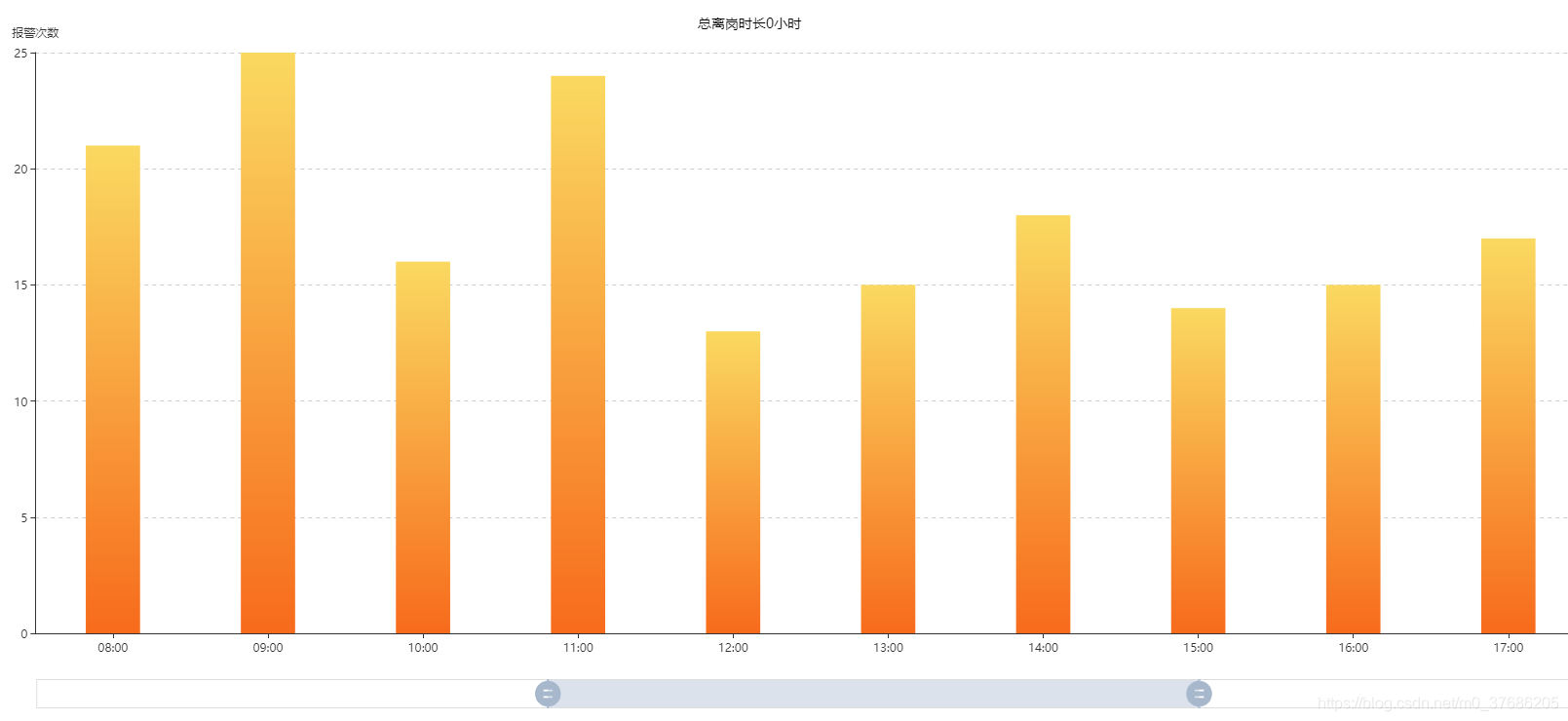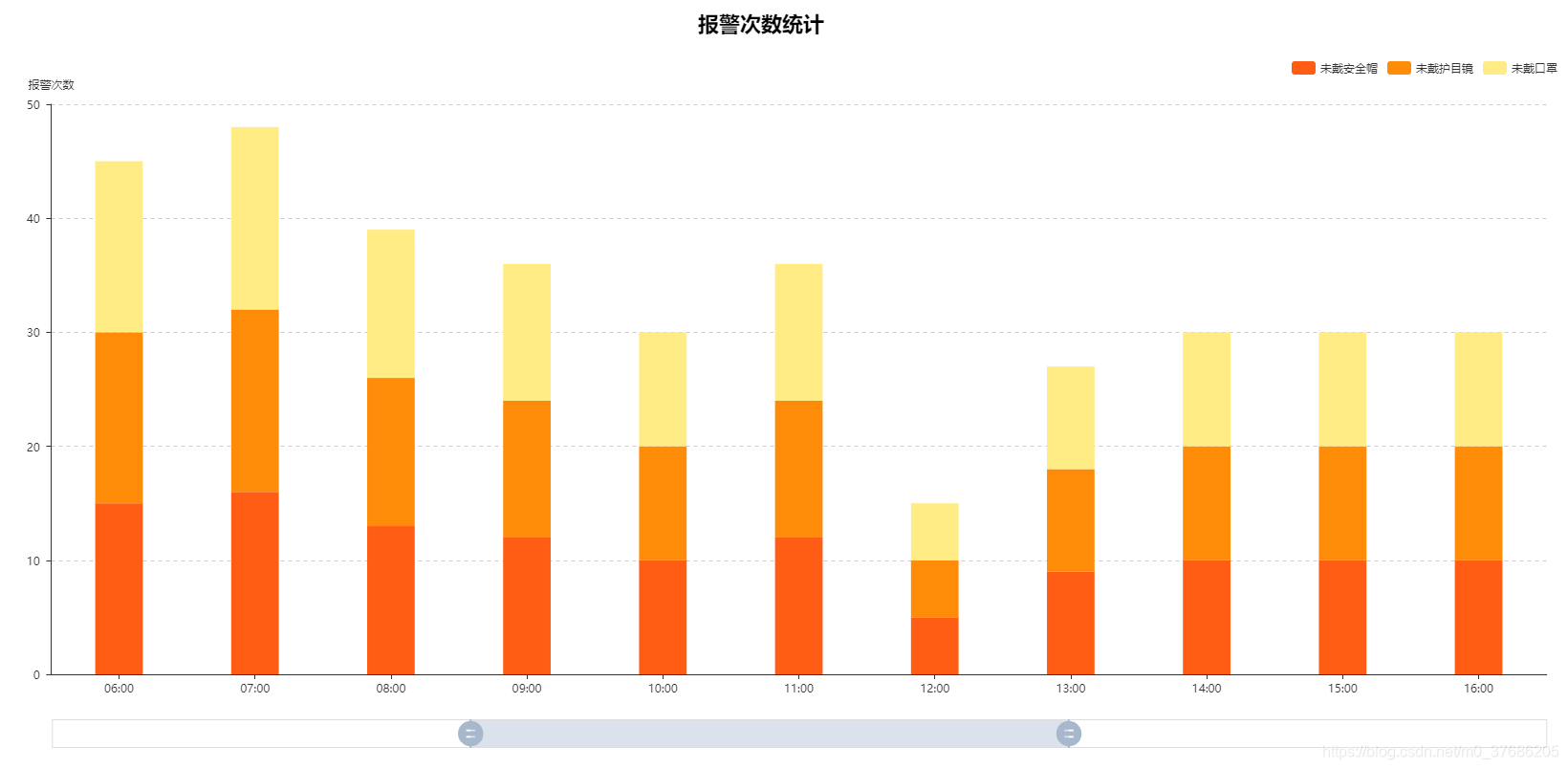Echarts介绍
Echarts是一个使用 JavaScript 实现的开源可视化库,可以很方便的以多彩的形式展示数据,使人一目了然。关于具体的使用,如有兴趣的可以参见官网说明 Echarts详细说明文档
Echarts–柱状图封装使用
这里我仅介绍Echarts中的柱状图的使用,包括渐变柱状图,堆叠柱状图的使用。其实不管是渐变柱状图还是堆叠柱状图都是柱状图,只是在图的数据option里变得更加复杂一点。在这里我主要拿渐变柱状图和堆叠柱状图来说明
- 图的封装:首先是单独建一个
Chart组件,做好基本的封装工作,代码如下
// 组件 Chart.vue
<template>
<div :id="id" :style="chartStyle"></div>
</template>
<script>
export default {
name: 'Chart',
data () {
return {
chart: ''
}
},
props: {
id: {
type: String
},
width: {
type: String,
default: '100%'
},
height: {
type: String,
default: '100%'
},
data: {
type: Array
},
option: {
type: Object
}
},
computed: {
chartStyle () {
return {
height: this.height,
width: this.width
}
}
},
methods: {
init () {
this.chart = this.$echarts.init(document.getElementById(this.id))
this.chart.setOption(this.option)
window.addEventListener('resize', this.chart.resize) // 图表自适应
}
},
mounted () {
this.$nextTick(function () {
this.init()
})
},
watch: {
// 观察option的变化
option: {
handler (newVal, oldVal) {
if (this.chart) {
if (newVal) {
this.chart.setOption(newVal)
} else {
this.chart.setOption(oldVal)
}
} else {
this.init()
}
},
deep: true // 对象内部属性的监听,关键。
}
}
}
</script>
- 图组件的使用,在需要使用
Chart组件的地方,引入该组件,传入对应的Id和绑定对应的配置选项option,如下代码
<el-row>
<el-col :span="24" style="height:800px;">
<!--报警区域统计-->
<Chart id="chartContainer1" :option="option1"></Chart>
</el-col>
</el-row>
- 图的数据填充。图的数据主要是对组件中
option的配置,在当前的父组件的data中设置数据,代码如下
option: {
title: [
// 设置主标题,包括标题的样式textStyle, 距离面板的位置
{
text: '报警次数统计',
textStyle: {
fontSize: 22,
color: '#000000'
},
itemGap: 20,
left: 730,
top: 30
},
// 有的地方需要有副标题,同样的有对应的样式
{
text: ' ',
subtext: '',
subtextStyle: {
color: '#000000',
fontSize: 14
},
itemGap: 20,
left: 730,
top: 40
}
],
// color对应的是图的柱子的颜色,如果不是渐变色,则color数组中展示一种颜色值即可,如果是渐变色,则需要如下的设置
color: [{
type: 'linear',
x: 0,
y: 0,
x2: 0,
y2: 1,
colorStops: [{
offset: 0, color: '#FAD961 '
}, {
offset: 1, color: '#F76B1C '
}],
global: false
}],
// 提示设置,当鼠标滑过某一根柱子的时候,提示框显示的样式,是直接显示柱子代表的值还是将整根柱子使用阴影的方式显示,显示的信息的怎么展示都可以设置
tooltip: {
trigger: 'axis',
formatter: '<b>{b}</b> :{c}次',
axisPointer: { // 坐标轴指示器,坐标轴触发有效
type: 'shadow'// 默认为直线,可选为:'line' | 'shadow'
}
},
// 设置整个图的位置,距离上下左右的距离等
grid: {
left: '2%',
right: '1%',
top: '15%',
bottom: '8%',
containLabel: true
},
// 设置x轴
xAxis: [
{
type: 'category',
axisTick: {
alignWithLabel: true
},
data: [
'00:00', '01:00', '02:00', '03:00', '04:00', '05:00', '06:00',
'07:00', '08:00', '09:00', '10:00', '11:00', '12:00', '13:00',
'14:00', '15:00', '16:00', '17:00', '18:00', '19:00', '20:00',
'21:00', '22:00', '23:00'
]
}
],
// 设置y轴,y轴的标题,对应的分割线等
yAxis: [
{
type: 'value',
name: '报警次数',
splitLine: {
lineStyle: {
type: 'dashed'
},
show: true
}
}
],
// 设置x坐标轴显示的范围
dataZoom: [
{
type: 'slider',
show: true,
start: 33,
end: 75,
showDataShadow: false,
// handleIcon是网络path路径,详见echarts文档
handleIcon: 'M10.7,11.9v-1.3H9.3v1.3c-4.9,0.3-8.8,4.4-8.8,9.4c0,5,3.9,9.1,8.8,9.4v1.3h1.3v-1.3c4.9-0.3,8.8-4.4,8.8-9.4C19.5,16.3,15.6,12.2,10.7,11.9z M13.3,24.4H6.7V23h6.6V24.4z M13.3,19.6H6.7v-1.4h6.6V19.6z'
}
],
// 真正的纵坐标显示的数据,这里的data可以是固定的数据。一般的初始化是空,后面可以根据后台的数据填充上去
series: [
{
name: '报警次数',
type: 'bar',
barWidth: '35%',
// data: [10,12,13,14,15,16.....]
data: []
}
]
}
效果如下图:

如果是堆叠柱状图,就是在series中多几组数据,然后将堆叠在同一根柱子上的数据使用字段stack规定一下,并在option中设置一下legend,显示在图的上方,作为辨认图的标识,具体代码如下
option: {
title: [
{
text: '报警次数统计',
textStyle: {
fontSize: 22,
color: '#000000'
},
itemGap: 20,
left: 730,
top: 20
}
],
// 图说明标识
legend: {
data: [ '未戴安全帽', '未戴护目镜', '未戴口罩' ],
right: 0,
top: 70
},
color: ['#FF5D13', '#FF8C09', '#FFEC85'],
tooltip: {
trigger: 'axis',
formatter: ['<b>{b}</b><br /> {a}: {c}'],
axisPointer: { // 坐标轴指示器,坐标轴触发有效
type: 'shadow'// 默认为直线,可选为:'line' | 'shadow'
}
},
grid: {
left: '2%',
right: '1%',
top: '15%',
bottom: '8%',
containLabel: true
},
xAxis: [
{
type: 'category',
axisTick: {
alignWithLabel: true
},
data: [
'00:00', '01:00', '02:00', '03:00', '04:00', '05:00', '06:00',
'07:00', '08:00', '09:00', '10:00', '11:00', '12:00', '13:00',
'14:00', '15:00', '16:00', '17:00', '18:00', '19:00', '20:00',
'21:00', '22:00', '23:00'
],
axisPointer: {
type: 'shadow'
}
}
],
yAxis: [
{
type: 'value',
name: '报警次数',
axisLabel: {
formatter: '{value} '
},
splitLine: {
lineStyle: {
type: 'dashed'
},
show: true
},
left: 10
}
],
dataZoom: [
{
type: 'slider',
show: true,
start: 28,
end: 68,
showDataShadow: false,
// handleIcon是网络path路径,详见echarts文档
handleIcon: 'M10.7,11.9v-1.3H9.3v1.3c-4.9,0.3-8.8,4.4-8.8,9.4c0,5,3.9,9.1,8.8,9.4v1.3h1.3v-1.3c4.9-0.3,8.8-4.4,8.8-9.4C19.5,16.3,15.6,12.2,10.7,11.9z M13.3,24.4H6.7V23h6.6V24.4z M13.3,19.6H6.7v-1.4h6.6V19.6z'
}
],
series: [
{
name: '未戴安全帽',
type: 'bar',
stack: '告警',
barWidth: '35%',
// [5, 10, 12, 5, 6, 13, 15, 16, 13, 12, 10, 12, 5, 9, 10, 10, 10, 11, 13, 5, 6, 8, 9, 2]
data: []
},
{
name: '未戴护目镜',
type: 'bar',
stack: '告警',
barWidth: '35%',
data: []
},
{
name: '未戴口罩',
type: 'bar',
stack: '告警',
barWidth: '35%',
data: []
}
]
}
效果如下图:

当需要具体的填充真实的数据的时候,可使用赋值方法将数据填充上去,如下代码:
API.getOffSiteAlarmStatistics(datas).then(res => {
// 设置两个表的离岗时长
this.option.title[1].subtext = '总离岗时长' + res.data.totalTime1 + '小时 '
this.option1.title[1].subtext = '总离岗时长' + res.data.totalTime2 + '小时 '
// 将后台获取的图表的数据替换data中的固定数据
this.option.series[0].data = res.data.timeCounts.map((item) => {
return item.offSiteCount
})
this.option1.series[0].data = res.data.regionCounts.map((item) => {
return item.offSiteCount
})
})









 本文介绍了如何使用Echarts库封装柱状图组件,包括渐变柱状图和堆叠柱状图的实现。通过创建独立组件,设置配置选项并填充数据,展示了柱状图的创建过程及其在实际应用中的效果。对于堆叠柱状图,额外解释了数据组织和在图表上的标识方法。
本文介绍了如何使用Echarts库封装柱状图组件,包括渐变柱状图和堆叠柱状图的实现。通过创建独立组件,设置配置选项并填充数据,展示了柱状图的创建过程及其在实际应用中的效果。对于堆叠柱状图,额外解释了数据组织和在图表上的标识方法。
















 1万+
1万+

 被折叠的 条评论
为什么被折叠?
被折叠的 条评论
为什么被折叠?








